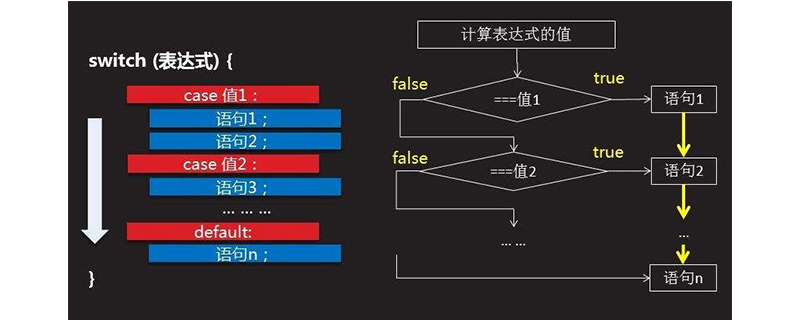What does the switch statement in JS do?
The switch statement is a flow control statement, used for multiple selection judgments in js. When the expression value is equal to the set value, the following statement is executed. You can use the break keyword to jump out of the switch statement
Those who have learned the Java language are no stranger to the switch statement. There is also a switch statement in JavaScript speech, and the usage of switch in js is no different from that in java. Next, I will share with you the usage of switch statement in JS

[Recommended course: JavaScript Tutorial】
switch statement
The switch statement is a common flow control statement. The meaning of each case in its statement is: if the expression is equal to this value, the following statement will be executed. The break keyword will cause the code flow to jump out of the switch statement. If the break keyword is omitted, the next case will continue to be executed after the current case is executed. The final default keyword is used to execute code when the expression does not match any of the previous situations.
switch statement usage
switch(变量){
case 变量值1:
console.log("a"); //若变量与变量值1相同则执行该处代码
break;
case 变量值2:
console.log("b"); //若变量与变量值2相同则执行该处代码
break;
case 变量值3:
console.log("c"); //若变量与变量值3相同则执行该处代码
break;
default:
console.log("d"); //若变量与所有的变量值不同,则执行该处的代码
}Example:
<script>
function myFunction()
{
var x;
var d=new Date().getDay();
switch (d)
{
case 0:
x="Today it's Sunday";
break;
case 1:
x="Today it's Monday";
break;
case 2:
x="Today it's Tuesday";
break;
case 3:
x="Today it's Wednesday";
break;
case 4:
x="Today it's Thursday";
break;
case 5:
x="Today it's Friday";
break;
case 6:
x="Today it's Saturday";
break;
}
document.getElementById("demo").innerHTML=x;
}
</script>Rendering:

The above is the detailed content of What does the switch statement in JS do?. For more information, please follow other related articles on the PHP Chinese website!

Hot AI Tools

Undresser.AI Undress
AI-powered app for creating realistic nude photos

AI Clothes Remover
Online AI tool for removing clothes from photos.

Undress AI Tool
Undress images for free

Clothoff.io
AI clothes remover

Video Face Swap
Swap faces in any video effortlessly with our completely free AI face swap tool!

Hot Article

Hot Tools

Notepad++7.3.1
Easy-to-use and free code editor

SublimeText3 Chinese version
Chinese version, very easy to use

Zend Studio 13.0.1
Powerful PHP integrated development environment

Dreamweaver CS6
Visual web development tools

SublimeText3 Mac version
God-level code editing software (SublimeText3)

Hot Topics
 1664
1664
 14
14
 1423
1423
 52
52
 1317
1317
 25
25
 1268
1268
 29
29
 1247
1247
 24
24
 Conditional control structures in PHP
Mar 10, 2024 pm 09:36 PM
Conditional control structures in PHP
Mar 10, 2024 pm 09:36 PM
Conditional control structure in PHP In PHP programming, conditional control structure is a very important syntax, which allows the program to execute different code blocks based on different conditions. By using conditional control structures, we can implement the branching logic of the program and determine the execution path of the program based on the result of the condition. This article will introduce the commonly used conditional control structures in PHP, including if statements, else statements, elseif statements and switch statements, and give specific code examples. The if statement is the most basic conditional control in PHP
 Go language basics - switch statement
Jul 24, 2023 pm 03:50 PM
Go language basics - switch statement
Jul 24, 2023 pm 03:50 PM
switch is a conditional statement that is used to calculate the value of a conditional expression to determine whether the value satisfies the case statement. If it matches, the corresponding code block will be executed. Is a common way to replace complex if-else statements.
 switch statement
Aug 11, 2023 am 10:54 AM
switch statement
Aug 11, 2023 am 10:54 AM
The switch statement is a control structure commonly used in programming, which allows the program to execute different code blocks based on different condition values. It can replace multiple if-else statements to improve the readability and maintainability of the code. Although it has some limitations, under the right circumstances, using the Switch statement can make programs more concise and efficient.
 How do Java enum types work with switch statements?
Apr 30, 2024 pm 06:48 PM
How do Java enum types work with switch statements?
Apr 30, 2024 pm 06:48 PM
Enumeration type is a data type in Java that defines a collection of constants. With the switch statement, the following functions can be achieved: Clearly represent the value range: The enumeration type is used to define a set of immutable constant values to improve code readability. Matching different enumeration constants: The switch statement allows different operations to be performed based on the enumeration constants to achieve refined control. Handling different scenarios: Through enumeration types and switch statements, various situations can be flexibly handled in actual scenarios, such as sending different email contents according to different notification types.
 How to use switch statement
Sep 21, 2023 pm 05:48 PM
How to use switch statement
Sep 21, 2023 pm 05:48 PM
Switch statement usage: 1. The Switch statement can only be used for integer types, enumeration types and String types, and cannot be used for floating point types and Boolean types; 2. Each case statement must be followed by a break statement to prevent other cases from being executed. The code block without a break statement will continue to execute the code block of the next case; 3. Multiple values can be matched in one case statement, separated by commas; 4. The default code block in the Switch statement is optional, etc. wait.
 How to use switch statement in Go language?
Jun 11, 2023 am 09:11 AM
How to use switch statement in Go language?
Jun 11, 2023 am 09:11 AM
Go language is an emerging programming language. It has the characteristics of efficiency, simplicity, security and concurrency, and is very suitable for use in fields such as web development, distributed systems and cloud computing. In the Go language, the switch statement is a very commonly used language structure, which can select different branches for execution based on the value of the expression. This article will introduce the basic usage and precautions of switch statements in Go language. Basic syntax: The switch statement in Go language is different from that in other programming languages.
 Local variable type inference in Java 10: How to use final var keyword in switch statement
Jul 31, 2023 pm 12:31 PM
Local variable type inference in Java 10: How to use final var keyword in switch statement
Jul 31, 2023 pm 12:31 PM
Local variable type inference in Java10: How to use finalvar keyword in switch statement As the Java language continues to evolve, each new version introduces some new features and improvements. In Java10, one of the important new features is local variable type inference. This feature allows developers to use the var keyword instead of explicit type declarations, making the code more streamlined and readable. This article will explore how to use the finalvar switch in a switch statement.
 Golang function switch statement application skills
May 16, 2023 am 08:26 AM
Golang function switch statement application skills
May 16, 2023 am 08:26 AM
As Golang continues to develop rapidly in recent years, it has become one of the preferred programming languages for many developers. Among Golang's many grammatical structures, the switch statement is undoubtedly a very important part. However, many developers may only use the simplest switch statement, but do not know much about the further application skills of the switch statement. This article will introduce some common application techniques of switch statements in Golang functions, in order to help readers better understand and apply s




